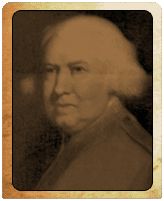
James Grant, Laird of Ballindalloch (1720-1806) was a major general in the British Army during the American Revolutionary War. He served as Governor of East Florida from 1763 to 1771.
Early career
Grant was born on the family estate of Ballindalloch in Banffshire in the Northeast of Scotland. He began his military career by purchasing a commission as captain in the Royal Scots on October 24, 1744. The regiment was shipped to the Continent and Grant fought with them in the Battle of Fontenoy (1745).
By 1757, Grant was a major of the 77th Regiment of Foot (Montgomerie's Highlanders), fighting in the French and Indian War. In 1758, he led part of the regiment in an expedition led by General John Forbes. On this expedition, he became acquainted with others who would also play larger parts in the American Revolutionary War: George Washington, Francis Marion, and Hugh Mercer, among others. He also gained a contempt for the colonial or militia troops that would colour his later views.
In September, Grant was assigned to lead an advance part of around 800 men to determine the French strength at Fort Duquesne. The force was mainly made up of militia, but he took along a number of officers from the regulars, since he had little respect for the colonial troops. He then decided to split his force hoping to encourage a French attack that he could surprise and overwhelm. Having no wilderness experience, he was ambushed himself by Indians and French on September 21, 1758. At this engagement, the Battle of Fort Duquesne, the British force was repelled with 342 men killed, wounded or captured. The prisoners consisted of Major Grant and 18 of his men. He was paroled soon after, and tried to blame his defeat on the failure of the colonial militia to follow orders.
In 1761, he commanded an expedition against the Cherokee during the Anglo-Cherokee War.
After being briefly stationed at Fort Ticonderoga, his regiment was moved to the Caribbean Theatre of the Seven Years' War. They fought at the Siege of Havana, held by Spanish forces, which ended in the surrender of the city. When the war was over, the regiment was disbanded in America in 1763.
The American Revolutionary War
Major General Howe arrived at Boston, on May 15, at the head of the 4,000 additional troops sent to General Thomas Gage. Gage's orders were to clear the American Army and break their Siege of Boston. Howe's plan was to take Cambridge, but the Americans fortified the high ground above the town.
Bunker Hill
By the summer of 1775, he was returned to active service, and Colonel Grant was ordered to America. He arrived in Boston on July 30. In the aftermath of the Battle of Bunker Hill, he urged General Gage to move the troops to New York City, to have room to maneuver. His advice was ignored at the time, and he remained as a supernumerary until December, when he was made colonel and commander of the 55th Regiment of Foot. He would hold that command until 1791.
His prediction that Boston was an untenable position was proved correct the following spring, and, on March 17, 1776, he accompanied the general withdrawal to Halifax, Nova Scotia. By the summer of 1776, General William Howe had replaced Gage as commander, and took Grant's advice about New York. Grant was given the provisional rank of major-general, and played several key parts in Howe's movements. Fortunately for the Americans, Howe refused advice from Grant, who proposed burning Boston, Marblehead, New York, and Philadelphia.
Battle for New York
As the New York Campaign sought to give the British control of New York City, Grant had become Howe's primary planning officer. He developed two plans, each of which was designed to both gain control of territory and to deal a serious or fatal blow to the American army. These resulted in the Battle of Brooklyn, and Battle of White Plains. Both of these were British victories, as was the overall campaign, but General Washington avoided the death blow each time.
In the Battle of Long Island on August 26th and 27th, Major General Grant led the division that landed on the left wing. He was to engage the American right and divert attention from Howe's flanking maneuver with the main body. Grant completed his mission, and severely defeated the American General William Alexander's division.
After the event, Grant was unfairly criticized by some for allowing the escape of most of this force. It is true that he had almost 5,000 men in ten regiments opposing Alexander's 1,700 Continentals, but there are two factors that mitigate this criticism. First, he stopped according to the plan, awaiting Howe's attack on the American rear, rather that attack to Americans dug in on the heights. Second, he was running low on ammunition, since the boats and logistic support were busy ferrying and supplying the Hessian units on the right and the main body that was landing at Gravesend.
PREVIOUS: General Sir William Howe | General James Grant | Biographies
